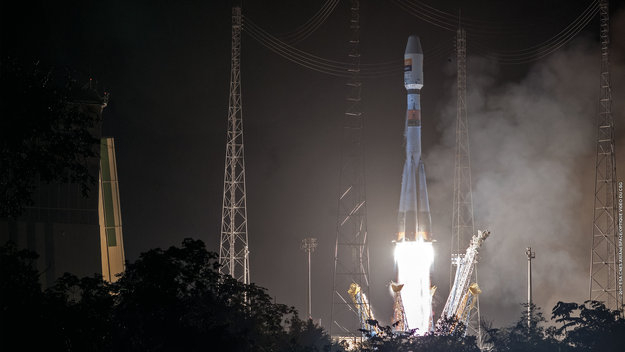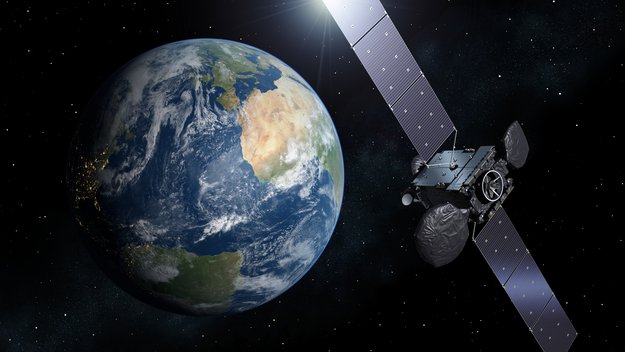http://www.esa.int/spaceinvideos/Videos/2017/01/SmallGEO_H36W-1_liftoff_replay
http://www.esa.int/esl/ESA_in_your_country/Spain/El_primero_vuelo_de_SmallGEO_llega_a_su_orbita
http://www.esa.int/Our_Activities/Telecommunications_Integrated_Applications/SmallGEO/SmallGEO_s_first_flight_reaches_orbit
El primero vuelo de SmallGEO llega a su órbita
28 enero 2017
La nueva pequeña plataforma de telecomunicaciones de la ESA ha sido lanzada en su primera misión a primera hora de la madrugada del 28 de enero.
El satélite Hispasat 36W-1, basado en la plataforma SmallGEO, despegó a bordo de un cohete Soyuz a las 01:03 GMT desde el Puerto Espacial Europeo de Kourou, Guayana Francesa.
SmallGEO constituye la respuesta de Europa a la demanda del mercado de plataformas de telecomunicaciones más flexibles y modulares. Se trata de la primera vez que el fabricante alemán de satélites OHB System AG actúa como contratista principal en una misión de satélites de telecomunicaciones. La carga útil de Hispasat, además, marca la primera colaboración de la ESA con un operador español.
El satélite de tres toneladas fue liberado por el lanzador a su órbita de transferencia 29 minutos después del despegue. Ahora empleará sus propios propulsores para alcanzar a lo largo de las próximas semanas su destino final: una órbita ‘geoestacionaria’ a una altitud de 36.000 km sobre el ecuador, desde la que se desplazará a la misma velocidad de rotación de la Tierra, a 36° O sobre el océano Atlántico.
OHB System probará el funcionamiento y el rendimiento del satélite, asegurándose de que su sensible tecnología haya salido ilesa del violento lanzamiento.
Una vez comprobados que todo funciona correctamente, se cederá el control a Hispasat y el satélite comenzará a ofrecer servicios de banda ancha a Europa, las Islas Canarias y Sudamérica.
“El lanzamiento de esta primera plataforma SmallGEO constituye un nuevo gran éxito del programa Sistema Avanzado de Investigación en Telecomunicaciones (ARTES) de la ESA, cuyo objetivo es promover la competitividad de la industria de los Estados miembros mediante la innovación”, señala Magali Vaissiere, directora de Telecomunicaciones y Aplicaciones Integradas de la ESA.
“SmallGEO se suma a nuestros esfuerzos continuos por reforzar la posición de las industrias europea y canadiense en el mercado de las telecomunicaciones comerciales, ampliando el catálogo de productos disponibles en la actualidad”.
“El próximo satélite basado en SmallGEO será EDRS-C, el segundo nodo del Sistema Europeo de Retransmisión de Datos”.
Carlos Espinós Gómez, CEO de Hispasat, añade: “Para Hispasat, este nuevo satélite representa un importante paso adelante en nuestra estrategia de innovación”.
“Hispasat 36W-1 no solo es la primera misión de la nueva plataforma SmallGEO, sino que incorpora una carga útil regenerativa avanzada que proporcionará al satélite una flexibilidad y calidad de la señal mayores gracias a su antena reconfigurable y a su procesador, pudiendo ofrecer así mejores servicios de telecomunicaciones a nuestros clientes”.
“Estamos muy satisfechos de nuestra colaboración con la ESA, que nos ha permitido participar en un proyecto tecnológico puntero al que ha añadido un valor significativo con sus conocimientos y su experiencia en el sector espacial”.
Por su parte, Marco Fuchs, CEO de OHB System AG, afirma: “Este lanzamiento constituye un hito clave en la historia de OHB. Hispasat 36W-1 demuestra que el concepto de una plataforma SmallGEO modular y flexible desarrollado por OHB encaja en el mercado”.
“SmallGEO está llamada a ser un pilar de las futuras actividades europeas en el segmento de los satélites geoestacionarios de tres toneladas”.
“Para OHB, Hispasat 36W-1 es el primer proyecto de un amplio abanico de futuras misiones basadas en la plataforma SmallGEO, incluyendo una revolución en la tecnología satelital: Electra, la misión de propulsión totalmente eléctrica”.
27 enero 2017 El despegue de la nueva pequeña plataforma geoestacionaria europea, está previsto para las 01:03 GMT del 28 de enero (02:03 CET, 22:03 del 27 de enero en hora local) a bordo de un cohete Soyuz. Será el vuelo inaugural de esta versátil plataforma.
SmallGEO transporta la carga útil de telecomunicaciones Hispasat 36W-1, marcando la primera colaboración entre la ESA y el operador español Hispasat y ofreciendo experiencia de vuelo para la plataforma de la alemana OHB System AG. Se trata del primer satélite de telecomunicaciones desarrollado, integrado y probado en Alemania en más de un cuarto de siglo. Además, será la primera vez que un lanzador Soyuz envíe un satélite de telecomunicaciones de más de tres toneladas a la órbita de transferencia geoestacionaria desde el Puerto Espacial Europeo de Kourou, Guayana Francesa.
El destino del satélite es una posición geoestacionaria a 36° O, desde donde ofrecerá cobertura de banda ancha a toda Europa, las Islas Canarias y el continente americano.
Esto será posible gracias a su innovadora carga útil REDSAT, que ofrece una mejor calidad de señal y cobertura terrestre flexible, al asignar de forma independiente y simultánea hasta cuatro haces reconfigurables de banda Ku, adaptando su potencia y orientación según la demanda. Combinado con una carga útil comercial tradicional con transpondedores avanzados en las bandas Ka y Ku, el sistema REDSAT permite mayores velocidades de transmisión. También puede convertir los datos recibidos en el estándar existente al nuevo estándar Difusión de Vídeo Digital de segunda generación (DVB-S2).
La plataforma SmallGEO y la misión Hispasat 36W-1 se han desarrollado en el marco del programa Sistema Avanzado de Investigación en Telecomunicaciones (ARTES) de la ESA, que transforma las inversiones en i+d en productos comerciales. Así, contribuirán a garantizar el éxito futuro de Europa y Canadá en el competitivo mercado mundial de las comunicaciones por satélite.
The first mission to use ESA's SmallGEO platform, Hispasat 36W-1, is launched from Europe's Spaceport in in French Guiana atop a Soyuz launcher.
SmallGEO is a multipurpose satellite platform capable of accommodating a wide range of commercial telecommunications payloads and missions, from TV broadcasting to multimedia applications, Internet access and mobile or fixed services in a wide range of frequency bands.
Its new, modular and flexible design boosts European industry’s ability to play a significant role in commercial satcoms by easing entry into the lower-mass telecom satellite market.
Its new, modular and flexible design boosts European industry’s ability to play a significant role in commercial satcoms by easing entry into the lower-mass telecom satellite market.
ESA
SmallGEO
SmallGEO's first flight reaches orbit
28 January 2017
ESA’s new small telecom platform was launched on its first mission in the early hours of this morning.
The Hispasat 36W-1 satellite, based on the SmallGEO platform, lifted off on a Soyuz rocket at 01:03 GMT this morning from Europe’s Spaceport in Kourou, French Guiana.
SmallGEO is Europe’s response to the market demand for more flexible, modular telecommunications platforms. It marks the first time the German satellite manufacturing company OHB System AG have been the prime contractor for a telecommunications satellite mission. Its Hispasat payload marks the first ESA partnership with a Spanish operator.
The three-tonne satellite was released by Soyuz into its transfer orbit 29 minutes after liftoff this morning. It will now use its own thrusters to make its way to its final destination over the course of the next few weeks.
It is heading towards ‘geostationary’ orbit at an altitude of 36 000 km over the equator, where it will take a day to circle Earth and therefore appear to hang over the same point, in this case at 36°W over the Atlantic Ocean.
OHB will test the satellite’s health and performance, making sure the sensitive technology made it unscathed through the violence of the launch.
After all is deemed well, they will hand the control over to Hispasat and the satellite will begin providing broadband services to Europe, South America and the Canary Islands.
“The launch of this first SmallGEO platform marks another major success for ESA’s programme of Advanced Research in Telecommunications Systems, known as ARTES, which aims to boost the competitiveness of its Member State industry through innovation,” noted Magali Vaissiere, ESA’s Director of Telecommunications and Integrated Applications.
“SmallGEO is part of our continuous efforts to strengthen the position of European and Canadian industry in the commercial telecommunications market, expanding the current range of available products.
“The next satellite based on SmallGEO will be EDRS-C, as the second node to the European Data Relay System.”
Carlos Espinós Gómez, CEO of Hispasat, said: “For Hispasat, this new satellite represents an important step forward in its innovation strategy.
“Hispasat 36W-1 is not only the first mission of the new SmallGEO platform, but also incorporates an advanced regenerative payload that will provide the satellite with greater flexibility and signal quality thanks to its reconfigurable antenna and onboard processor, thus improving the telecommunications services it will provide to our clients.
“We are very satisfied with our collaboration with ESA, which has allowed us to participate in a leading technological project to which they have added significant value with their knowledge and experience in the space sector.”
Marco Fuchs, CEO of OHB System AG, commented: “The launch is a major milestone in the history of OHB. Hispasat 36W-1 proves that OHB’s concept of a modular and flexible SmallGEO platform fits into the market.
“SmallGEO is destined to build a cornerstone for Europe’s future activities in the segment of geostationary satellites in the three-tonne class.
“For OHB, Hispasat 36W-1 is the first project of a wide scope of future missions based on the SmallGEO platform, including a revolution in satellite technology: the full electric propulsion mission Electra.”
“SmallGEO is part of our continuous efforts to strengthen the position of European and Canadian industry in the commercial telecommunications market, expanding the current range of available products.
“The next satellite based on SmallGEO will be EDRS-C, as the second node to the European Data Relay System.”
Carlos Espinós Gómez, CEO of Hispasat, said: “For Hispasat, this new satellite represents an important step forward in its innovation strategy.
“Hispasat 36W-1 is not only the first mission of the new SmallGEO platform, but also incorporates an advanced regenerative payload that will provide the satellite with greater flexibility and signal quality thanks to its reconfigurable antenna and onboard processor, thus improving the telecommunications services it will provide to our clients.
“We are very satisfied with our collaboration with ESA, which has allowed us to participate in a leading technological project to which they have added significant value with their knowledge and experience in the space sector.”
Marco Fuchs, CEO of OHB System AG, commented: “The launch is a major milestone in the history of OHB. Hispasat 36W-1 proves that OHB’s concept of a modular and flexible SmallGEO platform fits into the market.
“SmallGEO is destined to build a cornerstone for Europe’s future activities in the segment of geostationary satellites in the three-tonne class.
“For OHB, Hispasat 36W-1 is the first project of a wide scope of future missions based on the SmallGEO platform, including a revolution in satellite technology: the full electric propulsion mission Electra.”
ESA
Guillermo Gonzalo Sánchez Achutegui




No hay comentarios:
Publicar un comentario